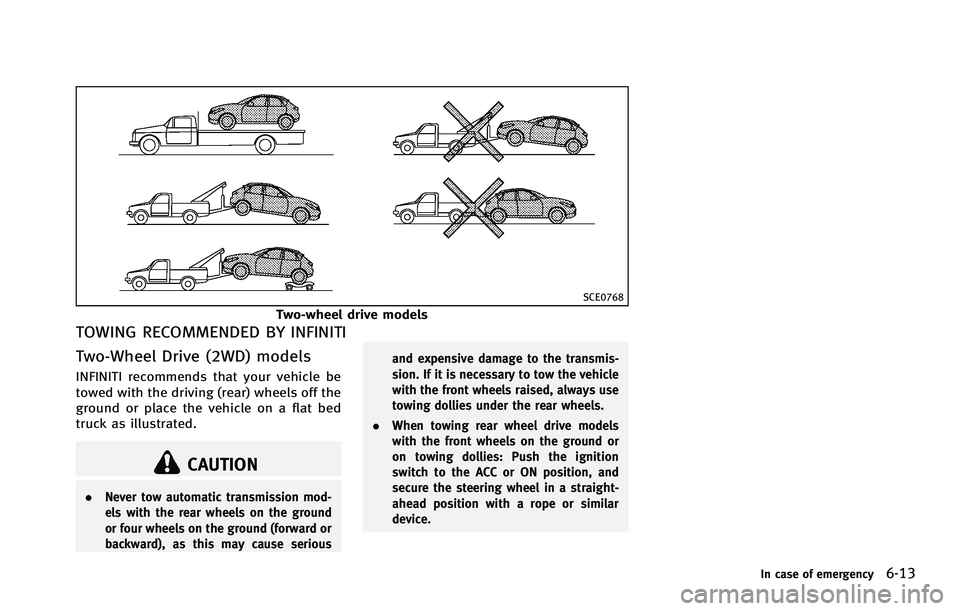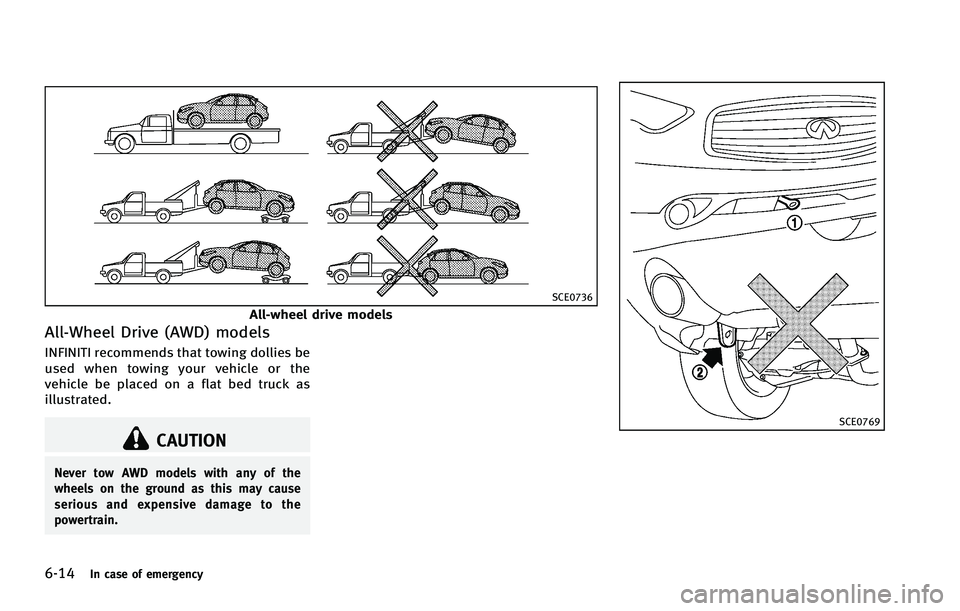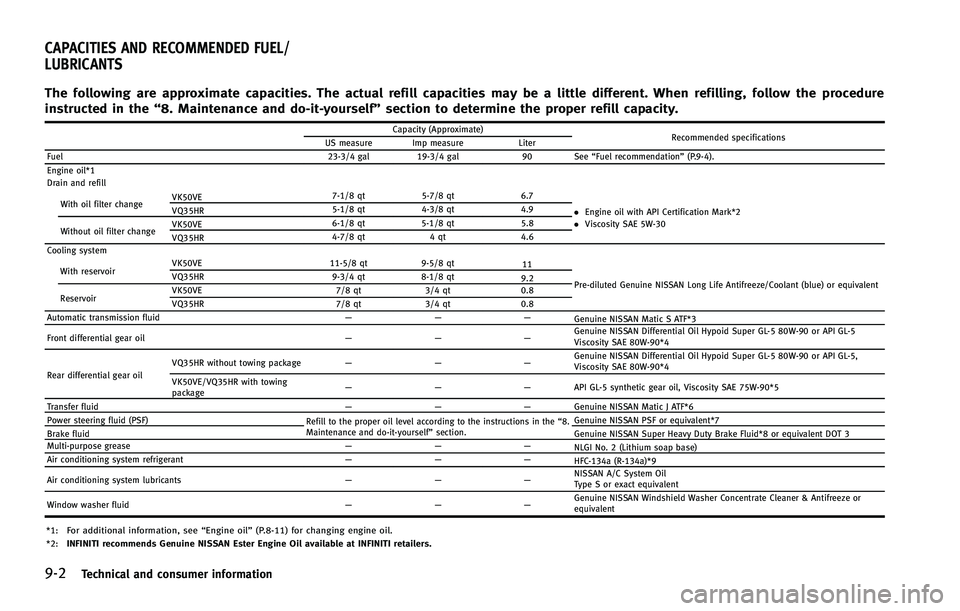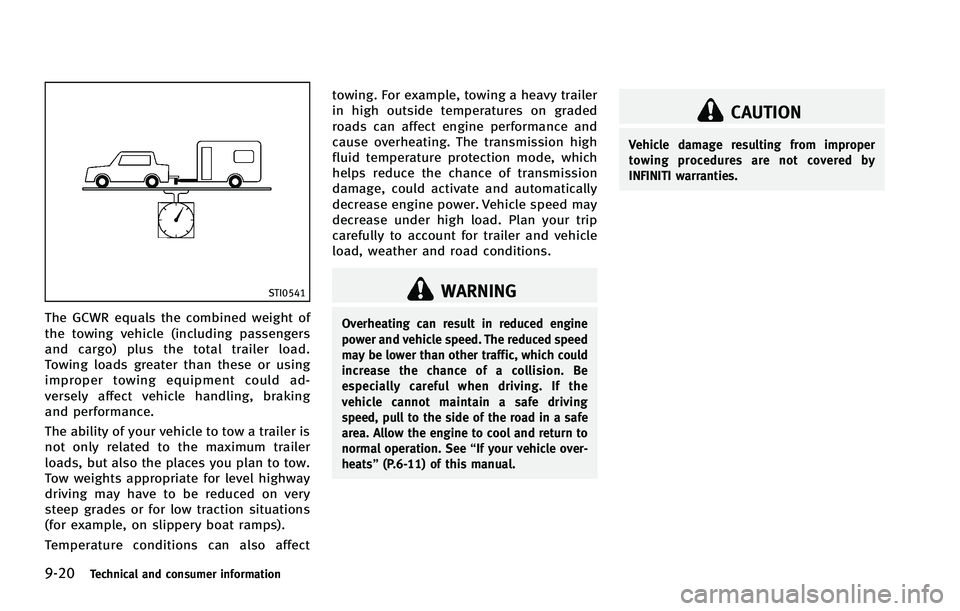towing INFINITI FX 2012 User Guide
[x] Cancel search | Manufacturer: INFINITI, Model Year: 2012, Model line: FX, Model: INFINITI FX 2012Pages: 522, PDF Size: 3.51 MB
Page 426 of 522

SCE0768
Two-wheel drive models
TOWING RECOMMENDED BY INFINITI
Two-Wheel Drive (2WD) models
INFINITI recommends that your vehicle be
towed with the driving (rear) wheels off the
ground or place the vehicle on a flat bed
truck as illustrated.
CAUTION
.Never tow automatic transmission mod-
els with the rear wheels on the ground
or four wheels on the ground (forward or
backward), as this may cause serious and expensive damage to the transmis-
sion. If it is necessary to tow the vehicle
with the front wheels raised, always use
towing dollies under the rear wheels.
. When towing rear wheel drive models
with the front wheels on the ground or
on towing dollies: Push the ignition
switch to the ACC or ON position, and
secure the steering wheel in a straight-
ahead position with a rope or similar
device.
In case of emergency6-13
Page 427 of 522

6-14In case of emergency
SCE0736
All-wheel drive models
All-Wheel Drive (AWD) models
INFINITI recommends that towing dollies be
used when towing your vehicle or the
vehicle be placed on a flat bed truck as
illustrated.
CAUTION
Never tow AWD models with any of the
wheels on the ground as this may cause
serious and expensive damage to the
powertrain.
SCE0769
Page 428 of 522

VEHICLE RECOVERY (freeing a stuck
vehicle)
WARNING
.Stand clear of a stuck vehicle.
. Do not spin your tires at high speed. This
could cause them to explode and result
in serious injury. Parts of your vehicle
could also overheat and be damaged.
Pulling a stuck vehicle
If your vehicle is stuck in sand, snow, mud,
etc., use a tow strap or other device
designed specifically for vehicle recovery.
Always follow the manufacturer’s instruc-
tions for the recovery device.
Securely install the vehicle recovery hook
*1stored with jacking tools as illustrated.
Attach the tow strap to the recovery hook.
Make sure that the hook is properly
secured in the original place after use.
Do not use the tie down hooks
*2for
towing or vehicle recovery.
CAUTION
. Tow chains or cables must be attached
only to the vehicle recovery hooks or
main structural members of the vehicle.
Otherwise, the vehicle body will be
damaged.
. Do not use the vehicle tie downs to free
a vehicle stuck in sand, snow, mud, etc.
. Never tow a vehicle using the vehicle tie
downs or recovery hooks.
. Always pull the cable straight out from
the front of the vehicle. Never pull on the
vehicle at an angle.
. Pulling devices should be routed so they
do not touch any part of the suspension,
steering, brake or cooling systems.
. Pulling devices such as ropes or canvas
straps are not recommended for use in
vehicle towing or recovery.
Rocking a stuck vehicle
If your vehicle is stuck in sand, snow, mud,
etc., use the following procedure:
1. Turn off the Vehicle Dynamic Control
(VDC) system. 2. Make sure the area in front and behind
the vehicle is clear of obstructions.
3. Turn the steering wheel right and left to clear an area around the front tires.
4. Slowly rock the vehicle forward and backward.
.Shift back and forth between R
(reverse) and D (drive).
.Apply the accelerator as little aspossible to maintain the rocking
motion.
.Release the accelerator pedal beforeshifting between R and D.
.Do not spin the tires above 35 MPH(55 km/h).
5. If the vehicle cannot be freed after a few tries, contact a professional towing
service to remove the vehicle.
In case of emergency6-15
Page 480 of 522

9 Technical and consumer information
Capacities and recommended fuel/lubricants....... 9-2Fuel recommendation ...................................... 9-4
Engine oil and oil filter recommendation ......... 9-6
Air conditioning system refrigerant and
lubricant recommendations ............................. 9-7
Specifications ...................................................... 9-8
Engine............................................................. 9-8Wheels and tires ............................................. 9-9
Dimensions ................................................... 9-10
When traveling or registering your vehicle in
another country ................................................. 9-11
Vehicle identification ......................................... 9-11 Vehicle Identification Number (VIN) plate ....... 9-11
Vehicle identification number
(chassis number) ........................................... 9-11
Engine serial number .................................... 9-12
F.M.V.S.S./C.M.V.S.S. certification label .......... 9-12
Emission control information label ................ 9-13
Tire and loading information label ................. 9-13
Air conditioner specification label.................. 9-13
Installing front license plate .............................. 9-14
Vehicle loading information ............................... 9-15 Terms ............................................................ 9-15 Vehicle load capacity ................................... 9-17
Securing the load ........................................ 9-18
Loading tips................................................. 9-18
Measurement of weights.............................. 9-19
Towing a trailer ................................................. 9-19 Maximum load limits ................................... 9-19
Maximum Gross Vehicle Weight (GVW)/
Maximum Gross Axle Weight (GAW) ............. 9-21
Towing load/specification ............................ 9-23
Towing safety............................................... 9-23 Flat towing................................................... 9-27
Uniform tire quality grading .............................. 9-28 Treadwear .................................................... 9-28
Traction AA, A, B and C................................ 9-28 Temperature A, B and C ............................... 9-28
Emission control system warranty ..................... 9-29
Reporting safety defects.................................... 9-30
Readiness for Inspection/Maintenance
(I/M) test .......................................................... 9-31
Event Data Recorders (EDR) ............................... 9-31
Owner’s Manual/Service Manual
order information .............................................. 9-32
Page 481 of 522

9-2Technical and consumer information
The following are approximate capacities. The actual refill capacities may be a little different. When refilling, follow the procedure
instructed in the“8. Maintenance and do-it-yourself” section to determine the proper refill capacity.
Capacity (Approximate)
Recommended specifications
US measure Imp measure Liter
Fuel 23-3/4 gal19-3/4 gal 90 See“Fuel recommendation” (P.9-4).
Engine oil*1
Drain and refill
With oil filter change VK50VE
7-1/8 qt
5-7/8 qt 6.7
.Engine oil with API Certification Mark*2
. Viscosity SAE 5W-30
VQ35HR
5-1/8 qt
4-3/8 qt 4.9
Without oil filter change VK50VE
6-1/8 qt
5-1/8 qt 5.8
VQ35HR 4-7/8 qt
4 qt4.6
Cooling system
With reservoir VK50VE
11-5/8 qt9-5/8 qt
11
Pre-diluted Genuine NISSAN Long Life Antifreeze/Coolant (blue) or equivalent
VQ35HR
9-3/4 qt8-1/8 qt
9.2
Reservoir VK50VE
7/8 qt3/4 qt 0.8
VQ35HR 7/8 qt3/4 qt 0.8
Automatic transmission fluid ———
Genuine NISSAN Matic S ATF*3
Front differential gear oil ———Genuine NISSAN Differential Oil Hypoid Super GL-5 80W-90 or API GL-5
Viscosity SAE 80W-90*4
Rear differential gear oil VQ35HR without towing package
——— Genuine NISSAN Differential Oil Hypoid Super GL-5 80W-90 or API GL-5,
Viscosity SAE 80W-90*4
VK50VE/VQ35HR with towing
package ———
API GL-5 synthetic gear oil, Viscosity SAE 75W-90*5
Transfer fluid ———Genuine NISSAN Matic J ATF*6
Power steering fluid (PSF) Refill to the proper oil level according to the instructions in the“8.
Maintenance and do-it-yourself” section. Genuine NISSAN PSF or equivalent*7
Brake fluid Genuine NISSAN Super Heavy Duty Brake Fluid*8 or equivalent DOT 3
Multi-purpose grease ———
NLGI No. 2 (Lithium soap base)
Air conditioning system refrigerant ———
HFC-134a (R-134a)*9
Air conditioning system lubricants ———NISSAN A/C System Oil
Type S or exact equivalent
Window washer fluid ———Genuine NISSAN Windshield Washer Concentrate Cleaner & Antifreeze or
equivalent
*1:
For additional information, see “Engine oil”(P.8-11) for changing engine oil.*2:INFINITI recommends Genuine NISSAN Ester Engine Oil available at INFINITI retailers.
CAPACITIES AND RECOMMENDED FUEL/
LUBRICANTS
Page 486 of 522

Oil which may contain foreign matter or
has been previously used should not be
used.
Oil viscosity
The engine oil viscosity or thickness
changes with temperature. Because of this,
it is important that the engine oil viscosity
be selected based on the temperatures at
which the vehicle will be operated before
the next oil change. Choosing an oil
viscosity other than that recommended
could cause serious engine damage.
Selecting the correct oil filter
Your new vehicle is equipped with a high-
quality genuine NISSAN oil filter. When
replacing, use the genuine oil filter or its
equivalent for the reason described in
change intervals.
Change intervals
The oil and oil filter change intervals for
your engine are based on the use of the
specified quality oils and filters. Oil and
filter other than the specified quality, or oil
and filter change intervals longer than
recommended could reduce engine life.
Damage to engines caused by improper
maintenance or use of incorrect oil andfilter quality and/or viscosity is not covered
by the new INFINITI vehicle limited warran-
ties.
Your engine was filled with a high quality
engine oil when it was built. You do not
have to change the oil before the first
recommended change interval. Oil and
filter change intervals depend upon how
you use your vehicle. Operation under the
following conditions may require more
frequent oil and filter changes.
.
repeated short distance driving at cold
outside temperatures,
. driving in dusty conditions,
. extensive idling,
. towing a trailer,
. stop and go “rush hour”traffic,
Refer to the “INFINITI Service and Main-
tenance Guide” for the maintenance sche-
dule.
AIR CONDITIONING SYSTEM RE-
FRIGERANT AND LUBRICANT RE-
COMMENDATIONS
The air conditioning system in your
INFINITI vehicle must be charged with the
refrigerant HFC-134a (R-134a) and the
lubricant, NISSAN A/C system oil Type S
or the exact equivalents.
CAUTION
The use of any other refrigerant or lubricant
will cause severe damage to the air con-
ditioning system and will require the repla-
cement of all air conditioner system
components.
The refrigerant HFC-134a (R-134a) in your
INFINITI vehicle will not harm the earth’s
ozone layer. Although this refrigerant does
not affect the earth’s atmosphere, certain
governmental regulations require the re-
covery and recycling of any refrigerant
during automotive air conditioning system
service. Your INFINITI retailer has the
trained technicians and equipment needed
to recover and recycle your air conditioning
system refrigerant.
Technical and consumer information9-7
Page 496 of 522

VEHICLE LOAD CAPACITY
Do not exceed the load limit of your
vehicle shown as“The combined
weight of occupants and cargo” on
the Tire and Loading Information
label. Do not exceed the number of
occupants shown as “Seating Capa-
city” on the Tire and Loading In-
formation label.
To get “the combined weight of
occupants and cargo” , add the
weight of all occupants, then add
the total luggage weight. Examples
are shown in the illustration.
Steps for determining correct load
limit
1.Locate the statement “The com-
bined weight of occupants and
cargo should never exceed XXX kg
or XXX lbs” on your vehicle’ s
placard.
2.Determine the combined weight of
the driver and passengers that
will be riding in your vehicle.
3.Subtract the combined weight of
the driver and passengers from
XXX kg or XXX lbs.
4.The resulting figure equals the
available amount of cargo and
luggage load capacity. For exam-
ple, if the XXX amount equals
1400 lbs. and there will be five
150 lb. passengers in your vehi-
cle, the amount of available cargo
and luggage load capacity is 650
lbs. (1400 −750 (5 x 150) = 650
lbs) or (640 −340 (5 x 70) = 300
kg.)
5.Determine the combined weight of
luggage and cargo being loaded
on the vehicle. That weight may
not safely exceed the available
cargo and luggage load capacity
calculated in Step 4.
6.If your vehicle will be towing a
trailer, load from your trailer will
be transferred to your vehicle.
Consult this manual to determine
how this reduces the available cargo and luggage load capacity
of your vehicle.
Before driving a loaded vehicle,
confirm that you do not exceed the
Gross Vehicle Weight Rating (GVWR)
or the Gross Axle Weight Rating
(GAWR) for your vehicle. (See “Mea-
surement of weights” (P.9-19).)
Also check tires for proper inflation
pressures. See the Tire and Loading
Information label.
Technical and consumer information9-17
Page 498 of 522

serious accident and personal in-
jury. Failures caused by overload-
ing are not covered by the
vehicle’s warranty.
MEASUREMENT OF WEIGHTS
Secure loose items to prevent weight
shifts that could affect the balance of
your vehicle. When the vehicle is
loaded, drive to a scale and weigh
the front and the rear wheels sepa-
rately to determine axle loads. In-
dividual axle loads should not
exceed either of the gross axle
weight ratings (GAWR). The total of
the axle loads should not exceed the
gross vehicle weight rating (GVWR).
These ratings are given on the
vehicle certification label. If weight
ratings are exceeded, move or re-
move items to bring all weights
below the ratings.
WARNING
Overloading or improper loading of a trailer
and its cargo can adversely affect vehicle
handling, braking and performance and may
lead to accidents.
CAUTION
.Do not tow a trailer or haul a heavy load
for the first 500 miles (800 km). Your
engine, axle or other parts could be
damaged.
. For the first 500 miles (800 km) that you
tow a trailer, do not drive over 50 MPH
(80 km/h) and do not make starts at full
throttle. This helps the engine and other
parts of your vehicle wear in at the
heavier loads.
Your new vehicle was designed to be used
primarily to carry passengers and cargo.
Remember that towing a trailer places
additional loads on your vehicle’s engine,
drivetrain, steering, braking and other
systems. An INFINITI Towing Guide (U.S. only) is
available on the website at www.InfinitiU-
SA.com. This guide includes information on
trailer towing capability and the special
equipment required for proper towing.
MAXIMUM LOAD LIMITS
Maximum trailer loads
Never allow the total trailer load to exceed
the value specified in the
“Towing Load/
Specification” chart. The total trailer load
equals trailer weight plus its cargo weight.
. When towing a trailer load of 1,000 lbs
(454 kg) or more, trailers with a brake
system MUST be used.
The maximum GCWR (Gross Combined
Weight Rating) should not exceed the value
specified in the following “Towing Load/
Specification” chart.
Technical and consumer information9-19
TOWING A TRAILER
Page 499 of 522

9-20Technical and consumer information
STI0541
The GCWR equals the combined weight of
the towing vehicle (including passengers
and cargo) plus the total trailer load.
Towing loads greater than these or using
improper towing equipment could ad-
versely affect vehicle handling, braking
and performance.
The ability of your vehicle to tow a trailer is
not only related to the maximum trailer
loads, but also the places you plan to tow.
Tow weights appropriate for level highway
driving may have to be reduced on very
steep grades or for low traction situations
(for example, on slippery boat ramps).
Temperature conditions can also affecttowing. For example, towing a heavy trailer
in high outside temperatures on graded
roads can affect engine performance and
cause overheating. The transmission high
fluid temperature protection mode, which
helps reduce the chance of transmission
damage, could activate and automatically
decrease engine power. Vehicle speed may
decrease under high load. Plan your trip
carefully to account for trailer and vehicle
load, weather and road conditions.
WARNING
Overheating can result in reduced engine
power and vehicle speed. The reduced speed
may be lower than other traffic, which could
increase the chance of a collision. Be
especially careful when driving. If the
vehicle cannot maintain a safe driving
speed, pull to the side of the road in a safe
area. Allow the engine to cool and return to
normal operation. See
“If your vehicle over-
heats” (P.6-11) of this manual.
CAUTION
Vehicle damage resulting from improper
towing procedures are not covered by
INFINITI warranties.
Page 500 of 522

STI0542
Tongue load
When using a weight carrying or a weight
distributing hitch, keep the tongue load
between 10 to 15% of the total trailer load
within the maximum tongue load limits
shown in the following“Towing Load/
Specification” chart. If the tongue load
becomes excessive, rearrange cargo to
allow for proper tongue load.
TI1012M
MAXIMUM GROSS VEHICLE WEIGHT
(GVW)/MAXIMUM GROSS AXLE
WEIGHT (GAW)
The GVW of the towing vehicle must not
exceed the Gross Vehicle Weight Rating
(GVWR) shown on the F.M.V.S.S./C.M.V.S.S.
certification label. The GVW equals the
combined weight of the unloaded vehicle,
passengers, luggage, hitch, trailer tongue
load and any other optional equipment. In
addition, front or rear GAW must not
exceed the Gross Axle Weight Rating
(GAWR) shown on the F.M.V.S.S./C.M.V.S.
S. certification label. Towing capacities are calculated assuming
a base vehicle with driver and any options
required to achieve the rating. Additional
passengers, cargo and/or optional equip-
ment, such as the trailer hitch, will add
weight to the vehicle and reduce your
vehicle’s maximum towing capacity and
trailer tongue load.
The vehicle and trailer need to be weighed
to confirm the vehicle is within the GVWR,
Front GAWR, Rear GAWR, Gross Combined
Weight Rating (GCWR) and Towing capacity.
All vehicle and trailer weights can be
measured using platform type scales com-
monly found at truck stops, highway weigh
stations, building supply centers or sal-
vage yards.
To determine the available payload capa-
city for tongue load, use the following
procedure.
1. Locate the GVWR on the F.M.V.S.S./C.M.
V.S.S. certification label.
2. Weigh your vehicle on the scale with all of the passengers and cargo that are
normally in the vehicle when towing a
trailer.
3. Subtract the actual vehicle weight from the GVWR. The remaining amount is the
Technical and consumer information9-21